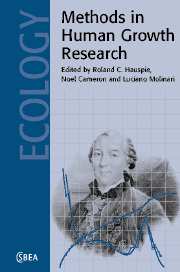14 results
Part IV - Special topics
-
- Book:
- Methods in Human Growth Research
- Published online:
- 17 August 2009
- Print publication:
- 24 June 2004, pp 331-332
-
- Chapter
- Export citation
Contents
-
- Book:
- Methods in Human Growth Research
- Published online:
- 17 August 2009
- Print publication:
- 24 June 2004, pp vii-viii
-
- Chapter
- Export citation
8 - Parametric models for postnatal growth
-
-
- Book:
- Methods in Human Growth Research
- Published online:
- 17 August 2009
- Print publication:
- 24 June 2004, pp 205-233
-
- Chapter
- Export citation
11 - Latent variables and structural equation models
-
-
- Book:
- Methods in Human Growth Research
- Published online:
- 17 August 2009
- Print publication:
- 24 June 2004, pp 287-305
-
- Chapter
- Export citation
Index
-
- Book:
- Methods in Human Growth Research
- Published online:
- 17 August 2009
- Print publication:
- 24 June 2004, pp 394-399
-
- Chapter
- Export citation

Methods in Human Growth Research
-
- Published online:
- 17 August 2009
- Print publication:
- 24 June 2004
List of Contributors
-
- Book:
- Methods in Human Growth Research
- Published online:
- 17 August 2009
- Print publication:
- 24 June 2004, pp ix-x
-
- Chapter
- Export citation
Part III - Methods for population growth
-
- Book:
- Methods in Human Growth Research
- Published online:
- 17 August 2009
- Print publication:
- 24 June 2004, pp 259-260
-
- Chapter
- Export citation
Part I - Growth data and growth studies: characteristics and methodological issues
-
- Book:
- Methods in Human Growth Research
- Published online:
- 17 August 2009
- Print publication:
- 24 June 2004, pp 1-2
-
- Chapter
- Export citation
Part II - Non-parametric and parametric approaches for individual growth
-
- Book:
- Methods in Human Growth Research
- Published online:
- 17 August 2009
- Print publication:
- 24 June 2004, pp 177-178
-
- Chapter
- Export citation
Acknowledgements
-
- Book:
- Methods in Human Growth Research
- Published online:
- 17 August 2009
- Print publication:
- 24 June 2004, pp xiv-xiv
-
- Chapter
- Export citation
Frontmatter
-
- Book:
- Methods in Human Growth Research
- Published online:
- 17 August 2009
- Print publication:
- 24 June 2004, pp i-vi
-
- Chapter
- Export citation
Foreword
-
- Book:
- Methods in Human Growth Research
- Published online:
- 17 August 2009
- Print publication:
- 24 June 2004, pp xi-xiii
-
- Chapter
- Export citation
2 - Modeling individual and average human growth data from childhood to adulthood
-
-
- Book:
- Problems and Methods in Longitudinal Research
- Published online:
- 27 April 2010
- Print publication:
- 12 December 1991, pp 28-46
-
- Chapter
- Export citation

